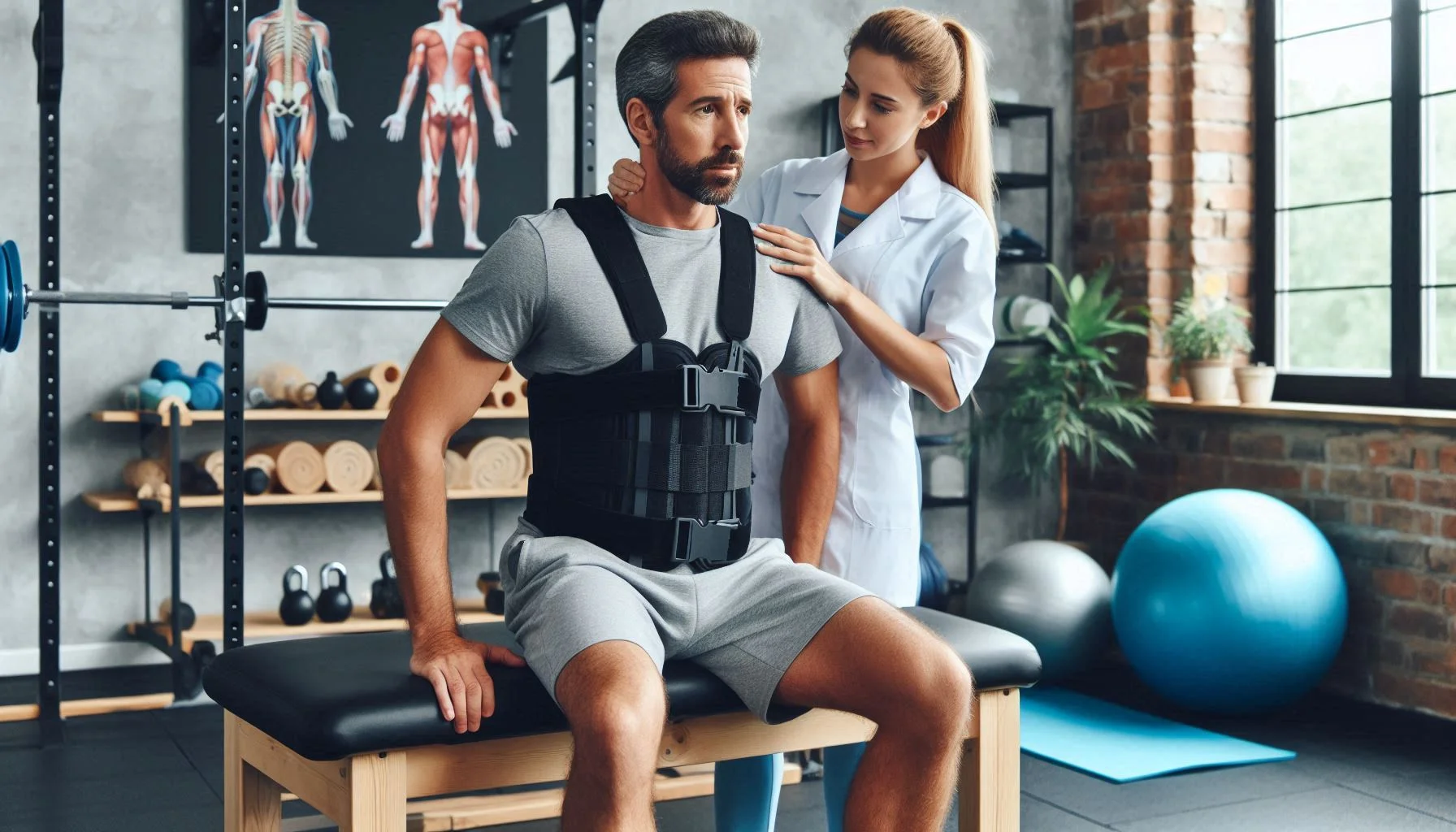Electrical stimulation therapy is a true alternative to conventional pain relief.
Many rely on medications, which can result in unwanted side effects. This non-invasive approach promotes healing and improves muscle function without the downsides.
It also helps to recover from injury and surgery, and it’s great for chronic pain sufferers.
Focus Physiotherapy uses this innovative method to boost rehabilitation by building muscles and improving blood flow.
Knowing how electrical stimulation helps you can take the power of your recovery into your own hands.
Read about how this therapy may be the key to unlocking better mobility and pain relief customized just for you.
What Is Electrical Stimulation Therapy?
1. Definition of Electrical Stimulation
Electrical stimulation therapy, known as e-stim, is a strong tool in physical rehabilitation. This effectively promotes multiple beneficial therapy results.
This noninvasive treatment uses electrical currents on specific areas of the body. It’s great at stimulating nerves and muscles, encouraging healing and relieving pain.
Essentially, it acts as an adjunctive therapy. This means you can use it along with other physical therapy techniques to speed up your recovery after injuries or illness.
2. Purpose and Goals of E-Stim
Electrical stimulation therapy has several uses. It seeks to ease pain, muscle spasms, and improve blood flow in the affected tissues.
Many people who receive this treatment notice immediate relief. They enjoy lasting benefits for up to 24 hours after their session.
E-stim is shown to significantly relieve chronic pain for up to 90% of people. This makes it a powerful tool for pain management strategies.
This may help you recover from peripheral nerve injuries that are caused by trauma, autoimmune diseases, or other medical conditions.
3. Mechanism of Action
So, how does electrical stimulation therapy work?
It stimulates the nerves, both sensory and motor. It does this through controlled electrical impulses. When these impulses are applied, they can block pain signals from reaching the brain, thereby providing relief.
Some forms of e-stim, including Neuromuscular Electrical Stimulation (NMES) and Russian stimulation, ask for your participation. You’ll have to contract your muscles during use of the device. You feel immediate benefits such as less pain and relaxed muscles. Plus, you take an active role in your rehabilitation process.
Types of Electrical Stimulation
Transcutaneous Electrical Nerve Stimulation
Transcutaneous Electrical Nerve Stimulation, or TENS, uses low-frequency electrical currents. This technique activates nerves to relieve pain.
This method helps you manage chronic pain conditions. It cuts in on pain signals before they ever hit the brain.
The TENS unit features electrodes that you place on your skin. It sends controlled electrical impulses, and you can adjust the intensity and frequency.
You can customize treatments to your specific needs by changing those parameters. This increases comfort and effectiveness as well.
Neuromuscular Electrical Stimulation
NMES passes electrical current through the electrodes and stimulates the motor nerves, which subsequently causes muscle contractions. This technique isn’t just important for rehabilitation; it also helps with functional movements like walking or standing.
NMES is particularly advantageous for those rehabilitating from injuries or surgeries. It maintains muscle strength and prevents atrophy in times of inactivity.
With advanced systems such as the Neuro20 PRO System, you can even target NMES to specific muscle groups. That means you can build personalized treatment plans that adjust to your individual recovery goals.
Iontophoresis Overview
Iontophoresis represents a novel application of electrical stimulation aimed at directly delivering medication across the skin barrier.
With this method, a small electrical charge pushes medication ions directly into the tissues. This allows it to target treatment without the need for injections.
Effectiveness of iontophoresis in treating inflammation and pain management. This technique can help break up calcium deposits associated with conditions like shoulder calcific tendonitis.
Russian Stimulation Techniques
Russian stimulation is a specific type of electrical stimulation that’s somewhat similar to NMES but uses a different waveform. This waveform’s alternative could offer some people higher comfort levels while still accomplishing effective muscle contractions.
Russian stimulation is typically used in athletic training or rehabilitation settings and can help augment strength training. If you start incorporating this technique into your routine, you might enjoy better muscle performance and recovery results.
Interferential Current Use
Interferential current (IFC) therapy uses four electrodes in a crisscross pattern. With this set-up, intersecting electrical fields are created within the body. This configuration reduces pain while simultaneously enhancing circulation to injured tissues.
IFC therapy is particularly effective for individuals with acute or chronic pain. It goes deeper than other types of electrical stimulation, delivering more effective relief.
Learning how to use IFC techniques can improve your therapeutic interventions.
High-Voltage Galvanic Current Details
High-voltage galvanic current therapy involves using high-voltage pulses sent through electrodes placed on the skin. This technique is mainly used to promote tissue healing and diminish swelling through increased blood flow and aid in cellular repair processes.
In the right hands, high-voltage galvanic current can offer some powerful benefits to those healing from injuries or surgeries. Knowing and understanding this method can help you respect its place in holistic rehab programs.
Benefits of Electrical Stimulation Therapy
Enhancing Muscle Function
This electrical stimulation therapy significantly powers up muscle function.
This is particularly effective for those struggling with muscle atrophy due to inactivity or age-related decline.
This therapy delivers electrical impulses that stimulate muscle contractions, which can help maintain and improve strength.
For older adults, this treatment is important because it helps them become more able to perform daily activities, which can become difficult.
Research shows that this stimulation actively improves muscle function. It also reduces the chances of further decline in muscle health.
Reducing Pain Levels
Chronic pain greatly diminishes overall quality of life, so finding effective methods for managing it is necessary.
Electrical stimulation therapy is shaping up as a potential breakthrough for chronic pain.
It effectively treats conditions like fibromyalgia, osteoarthritis, carpal tunnel syndrome, and low back pain.
The therapy interrupts pain signals sent to the brain. It also encourages the release of endorphins, which are natural pain relievers.
Studies show that about 69% of patients with chronic low back pain experience improvements. This therapy provides them with tremendous relief.
Electrical stimulation can reduce muscular spasms by essentially tiring the affected muscles out, offering additional pain relief.
Supporting Injury Recovery
Healing from injuries can take a long time and can be difficult, but electrical stimulation therapy provides significant assistance during recovery.
It’s helped patients recover from peripheral nerve injuries due to trauma or certain medical conditions. Through promoting peripheral nerve regeneration, electrical stimulation helps restore function and sensation to the affected areas.
This therapy is especially useful for post-stroke rehabilitation. It tackles muscle weakness following ACL repairs or total knee replacements, and it fights debilitation caused by serious illnesses.
Boosting Blood Circulation
Another major benefit of electrical stimulation therapy is improved blood circulation.
By increasing blood flow to specific areas, this treatment can help speed up healing and recovery.
Improved circulation delivers nutrients and oxygen to damaged tissue more effectively. This increase in blood flow dramatically accelerates healing from injuries and surgeries.
Electrical stimulation does wonders when combined with iontophoresis. This technique sends medications through the skin using electrical currents, greatly enhancing therapeutic effects.

Risks and Limitations of E-Stim
Potential Skin Irritation
Electrical stimulation therapy is generally effective for many conditions; skin irritation may occur in some people.
Typically, this irritation comes from the treatment’s electrodes. When you place electrodes on your skin, you may have localized redness or rashes. That irritation can happen with extended wear or if it’s not placed correctly.
Make sure your skin is clean and dry before applying electrodes. Hypoallergenic adhesive pads can reduce the chance of an allergic reaction.
If you experience any discomfort or lingering irritation, discontinue use immediately. It’s also important to contact a healthcare professional for advice.
Risk of Muscle Tear
Another big potential concern with electrical stimulation therapy is muscle tears.
The risk is predominantly linked to the intensity of the stimulation being stronger than the muscle can handle. High-frequency stimulation can make your muscles contract too quickly, overexerting them and leading to injury.
To minimize the chance of this happening, you can begin with smaller, more gradual stimulation. Listen very closely to how your body reacts.
It should go without saying that you should always consult a trained professional who can customize the therapy to your needs and abilities.
Possibility of Tissue Burns
Tissue burns are a major potential risk of electrical stimulation therapy.
Burns occur when the current is too strong. They also happen if the electrodes are on for prolonged periods without monitoring.
Too much current creates heat, which burns through the top and sometimes into the underlying tissue. This can lead to painful injuries that need medical intervention.
To avoid these results, follow the usage guidelines precisely. This encompasses timeframes for each session and setting the intensity to a reasonable percentage.
Frequent checks during treatment will reveal any early indications of discomfort or overheating.
Contraindications for Use
There are a few contraindications to be aware of prior to beginning electrical stimulation therapy.
Avoid this treatment if you have a pacemaker or any other implanted electronic device. It can disrupt how your device functions.
If you have a medical condition such as epilepsy, cancer, or an infection, speak to your healthcare provider before using e-stim therapies. Get professional guidance first, because your health matters.
Pregnant individuals should also use caution, as the effects on fetal development are unclear. A qualified health professional will carry out an assessment for you. This will help you understand the limitations and ensure that you’re able to safely benefit from electrical stimulation therapy.
Expected Experience During Treatment
Initial Assessment Procedures
Before you start electrical stimulation therapy, your physical therapist will assess you. This evaluation is critical to identifying which treatment modality is best for you.
During this assessment, the therapist will discuss your medical history, current symptoms, and any previous treatment experiences. They will likely perform a physical exam to find areas of discomfort or dysfunction that may respond well to electrical stimulation.
After the assessment, the therapist will describe the type of electrical stimulation they’ll be using. You’ll learn a lot more about the treatment in this discussion.
If they decide on Interferential Current (IFC), they’ll describe its ability to alleviate pain and improve blood circulation. This technique requires the application of four electrodes in a crisscross pattern.
Knowing the reasoning behind the method selected can help you feel more comfortable and involved during your treatment.
Sensations During Therapy
Depending on the type of e-stim you choose, you’ll feel different sensations while undergoing electrical stimulation therapy.
Patients often experience a mild tingling or pulsing sensation. This feeling happens while the electrical currents stimulate their targeted muscles or tissues.
When you use Electrical Muscle Stimulation (EMS), you’ll feel your muscles contracting rhythmically. This releases tension and increases blood flow in the area.
Some forms of e-stim — such as NMES and Russian stim — require you to actively participate. The therapy needs to be engaged while it’s being applied for it to have the best results.
Being active during treatment can actually help promote muscle recovery and strength development.
If you start to feel anything that is more than mildly uncomfortable, tell your therapist immediately. They can then adjust the settings to ensure your comfort.
Post-Treatment Expectations
After your electrical stimulation session, recovery and results can be expected in several ways.
After one session, many patients notice tremendous relief from muscle spasms, pain, and tightness. EMS does this for about 80-90% of those treated.
You may feel calm and have less discomfort in treated areas.
It’s important to understand that everyone’s reaction can vary. This variation depends on factors like overall health and the specific condition being treated.
Your therapist will probably give you some guidance on what you should do after treatment, such as activities or stretches that can help you recover even more.
They can schedule follow-up sessions to monitor progress and make any necessary adjustments to treatment plans.

Alternatives to Electrical Stimulation
Manual Therapy Options
Manual therapy includes various hands-on techniques to relieve pain and restore function. These methods include massage, joint mobilization, and manipulation. Each has its own application and approach, often determined by the patient’s preference.
Massage dissolves muscle tension and increases circulation. Joint mobilization aims to restore normal movement in stiff joints.
One of the reasons manual therapy is effective is that there’s a lot of research on it, including the use of manual therapy for chronic pain conditions.
This option offers patients a non-invasive alternative. It’s particularly useful for people who haven’t had success with electric stimulation therapies.
Working with a trained therapist provides individuals with personalized care. This personalized approach targets specific symptoms and encourages overall wellness.
Pharmacological Approaches
Pharmacological approaches include the use of medications to relieve discomfort and swelling.
Common pain prescriptions include nonsteroidal anti-inflammatory drugs (NSAIDs), opioids, and adjuvant medications such as antidepressants or anticonvulsants.
These medications can offer substantial benefits, but they also come with risks, such as dependence and side effects.
Chronic pain management is a big deal, costing the U.S. An estimated US$560 billion per year in lost productivity.
Pharmacological treatments are an important part of a holistic approach to controlling this pain.
While seeking out these forms of therapy, as well as others, consider these options.
This balanced approach will ensure you minimize risks and maximize efficacy.
Other Physiotherapy Techniques
Physiotherapy has a lot of other tricks in its bag besides electrical stimulation. These include therapeutic exercises, hydrotherapy, and heat or cold therapy.
Each one has a specific role to play. For example, therapeutic exercises focus on building strength and increasing flexibility, while hydrotherapy employs the properties of water to promote movement and reduce stress on the joints.
Advanced techniques such as H-Wave device stimulation (HWDS) emerged as a viable alternative.
HWDS is currently supported by moderate evidence for its use in acute and refractory chronic pain. It reliably enhances functional outcomes across a broad array of populations.
Unlike traditional electrical stimulation methods such as TENS, HWDS uses different frequency settings that specifically target pain relief.
Others, including tDCS, a type of brain training that sends an electrical current through the scalp, are relatively new and skeptical.
They found that tDCS was ineffective for reducing chronic back pain, according to a 2020 meta-analysis.
In comparison, repetitive transcranial magnetic stimulation (rTMS) has been FDA-cleared for other mental health conditions since 2008.
This reflects the changing landscape of physiotherapy practices that are finding new ways to serve patient needs.
Cost Considerations for E-Stim Therapy
Factors Influencing Cost
To determine the costs of electrical stimulation (E-stim) therapy, you must factor in several components. These factors can have a huge impact on the total cost you may incur.
The kind of E-stim device is the most significant factor. You can pick from a range of electrical stimulation options. These are non-invasive options and even subcutaneous modalities designed to ease pain or obtain more function.
The specific application—whether for rehabilitation, pain management, or training—will also impact the pricing structure.
Another major consideration is the equipment itself. The price of devices like H-Wave stimulators can range widely depending on their sophistication and application.
Moderate evidence exists for H-Wave device stimulation (HWDS) of both acute and chronic pain. However, it can be expensive and not always readily available.
Many people are still having trouble understanding how these devices work. There aren’t large-scale clinical trials demonstrating long-term effectiveness.
When determining operational costs, there are several factors practitioners should take into account. They have to factor in the cost of maintenance, training staff on how to use equipment properly, consumables, etc.
Insurance and Coverage Options
Navigating insurance coverage for E-stim therapy can be complex and varies significantly by provider and policy.
Many insurance plans may cover some types of electrical stimulation therapy if it is shown to be medically necessary. This usually consists of physician referrals or documentation that other modalities of treatment have failed.
Knowing your personal insurance policy is essential; some plans will need pre-authorization before they approve E-stim therapy. Some may restrict coverage to certain conditions or types of devices.
Chronic pain costs the economy about $560 billion each year in lost productivity. By utilizing effective treatment options such as E-stim therapy, we can alleviate this financial burden.
Patients should actively ask about out-of-pocket costs with their providers. This conversation will help clarify which parts of the treatment your insurance will cover. It will also flag any expenses you may need to pay out of pocket.
Access to effective treatments is key for chronic conditions. Anyone who wants to use E-stim therapy for relief needs to learn the ins and outs of insurance payment.


